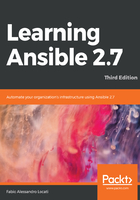
上QQ阅读APP看书,第一时间看更新
Using Ansible with Git
For the reasons that we have just seen, and because of its huge popularity, I suggest always using Git for your Ansible repositories.
There are a few suggestions that I always provide to the people I talk to, so that Ansible gets the best out of Git:
- Create environment branches: Creating environment branches, such as dev, prod, test, and stg, will allow you to easily keep track of the different environments and their respective update statuses. I often suggest keeping the master branch for the development environment, since I find that many people are used to pushing new changes directly to the master. If you use a master for a production environment, people can inadvertently push changes in the production environment when they wanted to push them in a development environment.
- Always keep environment branches stable: One of the big advantages of having environment branches is the possibility of destroying and recreating any environment from scratch at any given moment. This is only possible if your environment branches are in a stable (not broken) state.
- Use feature branches: Using different branches for specific long-development features (such as a refactor or some other big changes) will allow you to keep your day-to-day operations while your new feature is in the Git repository (so you'll not lose track of who did what and when they did it).
- Push often: I always suggest that people push commits as often as possible. This will make Git work as both a version control system and a backup system. I have seen laptops broken, lost, or stolen with days or weeks of un-pushed work on them far too often. Don't waste your time – push often. Also, by pushing often, you'll detect merge conflicts sooner, and conflicts are always easier to handle when they are detected early, instead of waiting for multiple changes.
- Always deploy after you have made a change: I have seen times when a developer has created a change in the infrastructure code, tested in the dev and test environments, pushed to the production branch, and then went to have lunch before deploying the changes in production. His lunch did not end well. One of his colleagues deployed the code to production inadvertently (he was trying to deploy a small change he had made in the meantime) and was not prepared to handle the other developer's deployment. The production infrastructure broke and they lost a lot of time figuring out how it was possible that such a small change (the one the person who made the deployment was aware of) created such a big mess.
- Choose multiple small changes rather than a few huge changes: Making small changes, whenever possible, will make debugging easier. Debugging an infrastructure is not very easy. There is no compiler that will allow you to see "obvious problems" (even though Ansible performs a syntax check of your code, no other test is performed), and the tools for finding something that is broken are not always as good as you would imagine. The infrastructure as a code paradigm is new, and tools are not yet as good as the ones for the application code.
- Avoid binary files as much as possible: I always suggest keeping your binaries outside your Git repository, whether it is an application code repository or an infrastructure code repository. In the application code example, I think it is important to keep your repository light (Git, as well as the majority of the version control systems, do not perform very well with binary blobs), while, for the infrastructure code example, it is vital because you'll be tempted to put a huge number of binary blobs in it, since very often it is easier to put a binary blob in the repository than to find a cleaner (and better) solution.